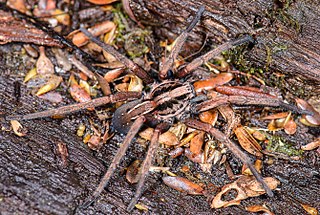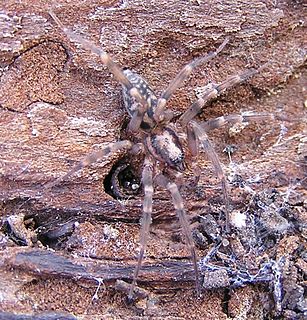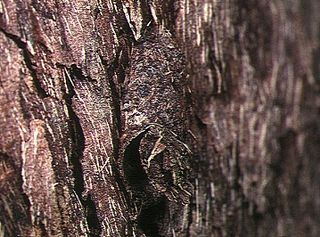
Huntsman spiders, members of the family Sparassidae, are known by this name because of their speed and mode of hunting. They also are called giant crab spiders because of their size and appearance. Larger species sometimes are referred to as wood spiders, because of their preference for woody places. In southern Africa the genus Palystes are known as rain spiders or lizard-eating spiders. Commonly they are confused with baboon spiders from the Mygalomorphae infraorder, which are not closely related.

Desidae is a family of spiders, some of which are known as intertidal spiders. The family is named for the genus Desis, members of which live in a very unusual location — between the tides. The family has been reevaluated in recent years and now includes inland genera and species as well, such as Badumna and Phryganoporus. In 2017, the family Amphinectidae was merged into Desidae. The family Toxopidae has been separated off. Those intertidal spiders that are truly marine commonly live in barnacle shells, which they seal up with silk; this allows them to maintain an air bubble during high tide. They emerge at night to feed on various small arthropods that live in the intertidal zone.

Miturgidae is a family of araneomorph spiders that includes nearly 170 species in 29 genera worldwide. First described by Eugène Simon in 1886, it has been substantially revised, including of previous family "Zoridae" as subfamily "Zorinae" and excluding the family "Xenoctenidae". Several genera have also been removed, such as the large genus Cheiracanthium, which was transferred to the Eutichuridae.

Liocranidae is a family of araneomorph spiders first described by Eugène Simon in 1897. They are one of several groups called "sac spiders". The holarctic genus Agroeca is the most well known, but it also includes various genera of more obscure spiders that still lack a diagnosis. Two species in the North American genus Neoanagraphis are found in the extremely dry conditions in the Mojave, Sonoran and Chihuahuan deserts. Females live in animal burrows while males wander and are the ones most often caught in pitfall traps.
Gasteracantha is a genus of orb-weaver spiders first named by Carl Jakob Sundevall in 1833. The females of most species are brightly colored with six prominent spines on their broad, hardened, shell-like abdomens. The name Gasteracantha is derived from the Greek gaster (γαστήρ), meaning "belly, abdomen", and akantha (άκανθα), meaning "thorn, spine". Spiny-backed orb-weavers are sometimes colloquially called "crab spiders" because of their shape, but they are not closely related to the true crab spiders. Other colloquial names for certain species include thorn spider, star spider, kite spider, or jewel spider.
Bulolia is a genus of Papuan jumping spiders that was first described by Marek Michał Żabka in 1996. As of June 2019 it contains only two species, found only in Papua New Guinea: B. excentrica and B. ocellata.

Diolenius is a genus of jumping spiders that was first described by Tamerlan Thorell in 1870.

Simaetha is a genus of Australasian jumping spiders that was first described by Tamerlan Thorell in 1881. They resemble members of Simaethula and Stertinius.

Telamonia is a genus of jumping spiders that was first described by Tamerlan Thorell in 1887. They are colorful spiders, with patterns that vary considerably between sexes and species. Two longitudinal stripes along the abdomen are common, and the carapace is often colored. They have a slender opisthosoma and long legs.

Zenodorus is a genus of the jumping spiders distributed from the Moluccas to Australia, including several islands of the Pacific. It was once considered a junior synonym of Omoedus, but this was later rejected. At least one species, Z. orbiculatus, specializes on hunting ants.

Idiopidae, also known as armored trapdoor spiders, is a family of mygalomorph spiders first described by Eugène Simon in 1889. They have a large body similar to tarantulas.

Nicodamidae is a family of araneomorph spiders with about thirty species in seven genera. They are small to medium-sized spiders found near the ground of eucalypt forests in small sheet webs. The species of this family are only present in Australia and Papua New Guinea. In most cases the cephalothorax and legs are uniformly red and the abdomen black, for which these species are sometimes called the "red and black spider".

Selenocosmia is a genus of tarantulas first described by Anton Ausserer in 1869.

Yule Island is a small island in Central Province, Papua New Guinea. It is located 160 km NW from Port Moresby, on the south coast of Papua New Guinea.
Cucudeta is a genus of Papuan jumping spiders that was first described by Wayne Paul Maddison in 2009. As of June 2019 it contains only three species, found only in Papua New Guinea: C. gahavisuka, C. uzet, and C. zabkai.

Conothele is a genus of mygalomorph spiders in the Halonoproctidae family, first described by Tamerlan Thorell in 1878. Originally placed with the Ctenizidae, it was moved to the Halonoproctidae in 2018.
Asmea is a genus of Papuan sheetweb spiders that was first described by M. R. Gray & H. M. Smith in 2008.
Phasmolia is a monotypic genus of Papuan jumping spiders containing the single species, Phasmolia elegans. It was first described by J. X. Zhang & Wayne Paul Maddison in 2012, and is only found in Papua New Guinea.
Variratina is a monotypic genus of Papuan jumping spiders containing the single species, Variratina minuta. It was first described by J. X. Zhang & Wayne Paul Maddison in 2012, and is found in Papua New Guinea.
Zabkattus is a genus of Papuan jumping spiders that was first described by J. X. Zhang & Wayne Paul Maddison in 2012.













